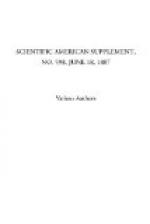obtained, and for each ship there are corresponding
data; that is, the powers, speeds, displacements,
revolutions, pitches, and other items existed at the
same time. There are a few points of detail about
these propellers which deserve a passing notice.
In Fig. 1 is shown a fore and aft section through the
boss. It will be observed that the flanges of
the blades are sunk into the boss, and that the bolts
are sunk into the flanges. The recess for the
bolt heads is covered with a thin plate having the
curve of the flange, so that the flanges and the boss
form a section of a sphere. This method of construction
is a little more expensive than exposed flanges and
bolts, which, however, render the boss a huge churn.
With the high revolutions at which these screws work,
a spherical boss is extremely desirable, but, of course,
the details need not be exactly as shown in the illustration.
The conical tail is fitted to prevent loss with eddies
behind the flat end of the boss, and is particularly
valuable with the screws of high speed ships.
The light hood shown on the stern bracket is for the
purpose of preventing eddies behind the boss of the
stern bracket, and to save the resistance of the flat
face of the screw boss. The edges of the blades
are cast sharp, instead of being rounded at the back,
with a small radius, as in the usual practice—the
object of the sharp edge being the diminution of the
edge resistance. The driving key extends the
whole length of the boss, and the tapered shaft fits
throughout its length.
[Illustration: Fig. 1.]
These points of detail have been features of all Admiralty
screws for some years.
The frictional resistance of screw propellers is always
a fruitful source of inefficiency. With a given
screw, the loss due to friction may be taken to vary
approximately as the square of the speed. This
is not to say that the frictional resistance is greater
in proportion to the thrust at high than at low speeds.
The blades of screws for any speed should be as smooth
and clean as possible, but for high speed screws the
absolute saving of friction may be considerable with
an improvement of the surface. There is no permanent
advantage in polishing the blades. No doubt there
is some advantage for a little time, and, probably,
better results may thereby be secured on trial, but
the blades soon become rough, and shell fish and weed
appear to grow as rapidly on recently polished blades
as on an ordinary surface. These screws are of
gun metal. They were fitted to the ships in the
condition in which they left the foundry. It appears
that within certain limits mere shape of blade does
not affect the efficiency of the screw, but, with
a given number of blades and a given disk, the possible
variations in the form or distribution of a given area
are such that different results may be realized.
The shapes of the blades of these propellers are shown
in Figs. 2, 3, and 4. It will be seen the shapes
are not exactly the same for all the screws, but the
differences do not call for much remark.




